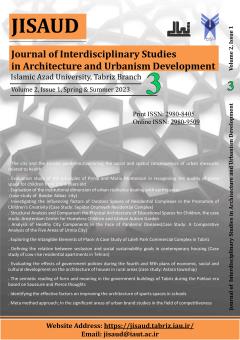Evaluation of the institutional dimension of urban resilience in dealing with earthquakes (case example of Bandar Abbas city)
Subject Areas :MOHAMMAD REZA JABERINASAB 1 , Akbar AbdollahzadehTaraf 2 , Arash Saghafi 3 , Hasan Sattari 4
1 - Department of Architecture, Tabriz Branch, Islamic Azad University, Tabriz, Iran.
2 - Urbanism, Architecture and art, Tabriz Branch. Islamic Azad University, Tabriz, Iran.(Crresponding Author)taraffarat@yahoo.com
3 - Assistant Professor, Department of Urban Planning, Tabriz Branch, Islamic Azad University.
4 - Department of Architecture, Tabriz Branch, Islamic Azad University, Tabriz, Iran.
Keywords: resilience, Crisis, urban management, natural disasters.Abstract,
Abstract :
Natural disasters such as floods, earthquakes, and tornadoes have always existed and will continue to exist throughout the life of the planet, but the noteworthy point is that the effects of these natural disasters do not disappear completely and their effects can only be balanced. Urban tissues and man-made elements of urban spaces are worn out and destroyed over time, and for this reason, keeping urban bodies stable requires interventions to improve and improve the existing situation, and this shows the necessity of physical interventions in the tissue. Uneven urban spaces are a reflection of the social and economic inequalities of their residents, although natural disasters and events threaten most cities, but the poor who live in informal settlements and dilapidated structures face greater human and financial losses when natural disasters occur. be. The main goal of this research is to evaluate the institutional dimension of urban resilience in dealing with earthquakes, focusing on the city of Bandar Abbas. The present research method was a descriptive-analytical method. The statistical population included all the expert employees of the Crisis Management Organization of Bandar Abbas Governorate and other agents of the Crisis Headquarters, which was determined by using the Cochran sample size formula to determine the number of 35 people as the sample size. The research tool was a researcher-made questionnaire based on the theoretical framework of the research. The reliability of the tool was confirmed using Cronbach's alpha test above 0.65. According to the research results, the level of institutional resilience has not been at an acceptable level.Natural hazards have been with humans since the beginning of time, and humans have always sought a way to deal with them. Disasters are events that occur unexpectedly and sometimes inevitably, and due to the spread over material and human resources and interruption of the natural process of life, they are beyond the capacity of societies to adapt. The effects and consequences of a natural disaster, regardless of its type, can remain for a long time after the incident (Fali, 2014). On the other hand, population growth, increase in urban population and population density in a specific area have doubled the risk of these accidents. The lack of preparation for such incidents increases the losses and sometimes causes huge disasters (Noorian and Esfandi, 2014: 56). At the beginning of the 20th century, crisis management initially only had the ability to respond and react immediately after the incident and the occurrence of the crisis (Davis, 2011). After the inefficiency of this system showed itself in many situations, the attention of urban planners and managers was drawn to its resilience and increase (Coppola, 2007). Resilience has been discussed since the 1970s, which was first about ecological systems in the sense that resilience determines the continuity of relationships and links within a system and is a measure of the system's ability to absorb changes in parameters and stable variables. And moving and maintaining survival.
_||_


